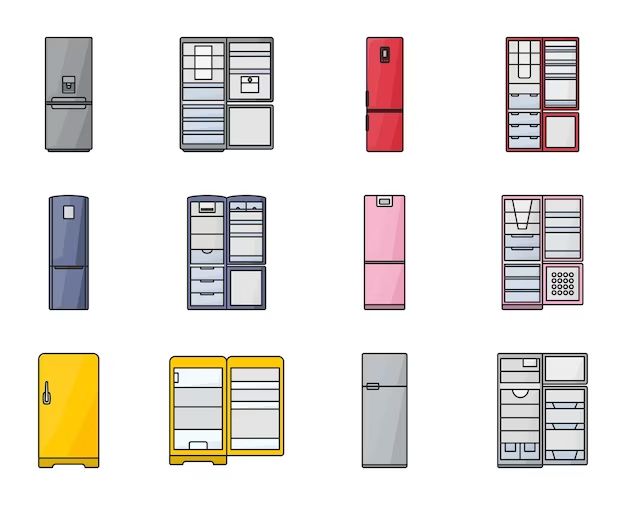Having a frozen water line leading to your refrigerator can be a frustrating problem. Not only does it prevent you from using the water dispenser and ice maker, but it can also lead to leaks and damage if the line bursts. Thankfully, unfreezing a frozen refrigerator water line is possible with some patience and the right techniques.
Page Contents
What causes refrigerator water lines to freeze?
There are a few common reasons why refrigerator water lines freeze up:
- Low temperatures – If temperatures drop below freezing for an extended period, exposed water lines can freeze up. This is most common during the winter.
- Lack of insulation – Refrigerator water lines that aren’t properly insulated are more prone to freezing.
- Door left open – If the refrigerator door is accidentally left open, cold air can quickly freeze components, including water lines.
- Clogged line – Small blockages or kinks in the line can prevent water from flowing smoothly, allowing it to freeze.
- Refrigerator problem – A malfunctioning refrigerator may not maintain proper temperatures in the freezer, causing freezing issues.
How to prevent water lines from freezing
It’s always better to try and prevent frozen water lines instead of dealing with the aftermath. Here are some tips to help avoid freezing:
- Insulate exposed pipes – Use pipe insulation or heating tape products to wrap any exposed water lines leading to the refrigerator.
- Seal openings – Caulk or seal any cracks and openings around refrigerant lines to prevent cold air leaks.
- Set warm temperatures – Keep refrigerator temperatures above 35°F and freezer temperatures below 15°F.
- Turn off automatic ice maker – This will stop water from continuously cycling through the line when not in use.
- Close doors – Make sure refrigerator doors seal properly and are kept closed to maintain interior temperatures.
How to unfreeze a frozen refrigerator water line
If your refrigerator water line has already frozen, follow these steps to safely thaw it:
- Shut off the water supply – Locate the water valve behind the refrigerator and turn it off. This prevents more water from entering the frozen line when thawing.
- Open freezer and fridge doors – This allows warm air to start circulating around the ice maker and frozen water line.
- Use a hairdryer – Focus gentle heat from a hairdryer directly on the frozen section of the water line. This slowly melts the ice blockage.
- Apply heat tape – Wrap self-regulating heat tape around the frozen section and plug it in. The tape warms to ~55°F.
- Pour warm water – Concentrate along the frozen area using a turkey baster or small funnel. Allow time for the water to penetrate the ice.
- Check progress – Test the water line to see if water flows through. If ice remains, repeat applying heat until the line is clear.
- Turn water supply back on – Once fully thawed, open the refrigerator water valve again to resume normal operation.
Things to avoid when thawing frozen lines
- Excessive heat – High heat sources like an open flame or boiling water can damage plastic water lines.
- Metal tools – Avoid picks or metal wire for breaking up ice, as these can puncture and split the line.
- Jerking or tugging – Pulling forcefully on a frozen line risks cracking it and causing leaks.
Tips for speeding up the thawing process
It’s tempting to try anything possible to quickly unfreeze a blocked refrigerator line. But many commonly proposed tips are ineffective or risky. Here are safe suggestions to help expedite the process:
- Direct fans towards freezer – Extra airflow speeds ice melting.
- Remove ice maker cover – Direct access speeds heating and thawing.
- Insulate freezer walls – Less cold air leaking out retains heat.
- Add extra heat sources – Heating pads or multiple hairdryers thaw ice faster.
- Check often – Frequently test water flow so heat can be removed once thawed.
| Method | Works Well For | Potential Risks |
|---|---|---|
| Hair dryer | Thawing small sections and checking progress. | Heat damage if left in one spot too long. |
| Heating tape | Thawing along entire water line safely. | Electric shock if improperly used. |
| Hot water | Thawing partial blockages quickly. | Water damage, burst pipes if excess water used. |
| Salt | Helps ice melt faster when applied. | Corrosion damage to pipes long-term. |
When to call for professional help
With patience, most frozen refrigerator lines can be thawed at home without issue. But in certain situations, it pays to call in a professional:
- Frozen line is inaccessible in back of unit.
- Significant water leakage or burst section.
- No progress after several thawing attempts.
- Concern over proper use of heating tools.
- Unsure how to turn off home water supply.
A qualified appliance repair technician can use commercial thawing equipment to clear the blocked line. They can also properly inspect the line for any cracks and leaks.
Prevent future freezing problems
Once you get your refrigerator water line cleared, take steps to avoid a repeat freezing incident:
- Insulate all exposed parts of water line.
- Seal openings and cracks allowing cold air leaks.
- Install newer CTS anti-freeze water supply kits.
- Keep refrigerator unit away from cold drafts.
- Set refrigerator to optimal cool temperatures.
Routinely check that water is flowing properly through the line. Address any new freezing issues promptly before ice blockages form again.
Conclusion
Frozen refrigerator water lines can seem like a daunting issue, but can be thawed with a bit of knowledge and the right approach. Focus thawing efforts near the freezer using warm water or heating tools. Avoid excessive force or heat. If needed, call in an appliance repair technician for professional assistance. With updated insulation and proper refrigerator operation, future freezing can be prevented.
